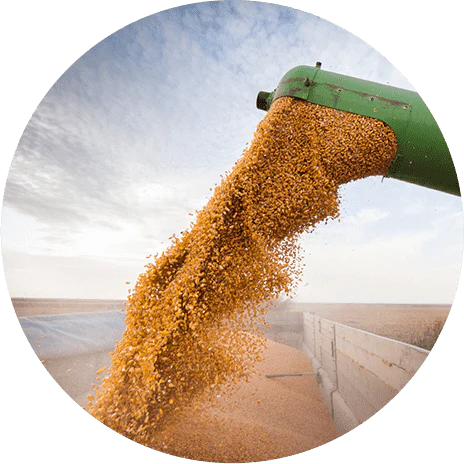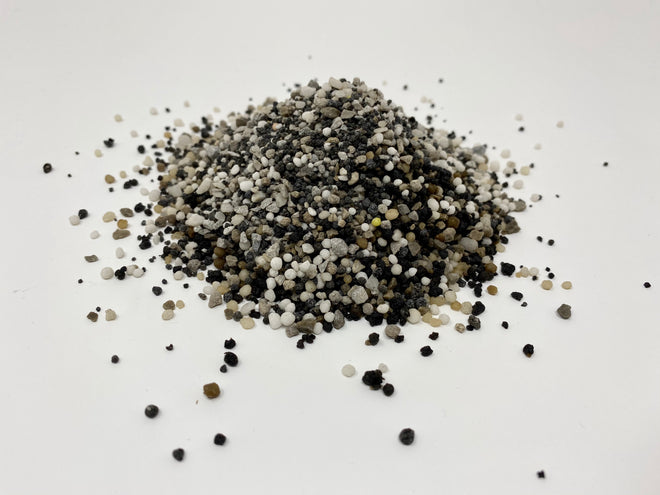
- When to plant:
- Spring, Summer
- Fertilizer:
- Hancock's 16-04-08 Lawn & Pasture Fertilizer
- Seeding rate:
- 30 lbs. per acre
- Overseeding rate:
- 20 lbs. per acre
- Seeding depth:
- 1/4 - 3/8 inch
- Ideal ph:
- 5.0 - 7.0
- Gmo:
- Non-GMO Hybrid
- Inoculant needed:
- No
- Coated or raw:
- Coated
- Lifecycle:
- Perennial
- Climate zones:
- Transition Zone, Warm Season
Mulato II Grass Seed is a vigorous-growing, warm season pasture or forage grass adapted to the tropical and subtropical regions around the world. Mulato II is especially attractive for beef and milk production operations.
Product Information
- Application or Use: Pasture, Cattle Forage, Hay Production, Livestock Forage
- Germination Time: 7 - 14 days, under optimal conditions
- Growing Locations: Warm Season & Transition Zone
- Height: Up to 9 feet, under optimal conditions
- Sunlight Requirements: 6+ hours, full sun for best results
- Advantages: Vigorous growth and superior nutritive value compared to Bahia grass.
- When to Plant: Recommended planting time is spring and summer when night time temperatures are consistently 65+ degrees.
Product Detail
- Fast growing
- Well drained soils
- Drought resistant
- Good forage
- Non-gmo hybrid
Product Information
Mulato makes excellent haylege or dry hay as well. Mulato should be planted in well-drained soil areas that receive little frost for best results.
Plant architecture is characterized by 9 to 10 leaves per stem, arranged horizontally to form a dense, leafy plant coverage. All these factors increase forage consumption as well as the efficiency of pasture use. Its intense green, cylindrical stems, measuring from 21.7 to 31.5 in. long, are also densely pubescent. Plant height ranges from 35.4 to 39.4 in. Its intense green, linear-lanceolate leaves have abundant pubescence. In addition, Mulato II has very deep, branched roots, which gives it excellent resistance to drought.
Mulato II has high dry matter production, good forage quality, tolerance to spittlebug and it is a tall vigorous grass for cutting. This grass is also highly palatable to grazing ruminants.
Mulato II has excellent nutritional characteristics in terms of crude protein (CP) content and digestibility. Although both parameters vary depending on the age of the grass and the time of the year, in general this grass yields between 14 to 21% CP and its in vitro digestibility in regrowths of 25 to 35 days is between 55 to 66%.
Cv. Mulato has partial resistance to spittlebugs. In the ongoing breeding program at CIAT, a group of hybrids has been identified with high levels of antibiosis resistance to spittlebugs Aeneolamia varia, A. reducta, and Zulia carbonaria, whilst another group of hybrids showed field resistance to Z. pubescens and Mahanarva trifissa.
There are currently two Brachiaria spp. hybrids developed as forages and further combinations of species may be developed as hybrids in the future.
*Product packaging may appear different than what is pictured.
Mulato II can be easily established by planting seed. Its seedlings present high growth vigor, so it is possible to obtain an established pasture with more than 80% coverage between 60 and 90 days after planting. We recommend a rate of 20-30 lbs. per acre for good establishment during the spring and summer months. Please remember that seed should not be planted at more than 3/4 of an in. in depth to avoid problems of low seedling emergence.
Because of its superior forage quality and excellent forage production, Mulato II is suitable for intensive rotational management. The recovery capacity of this grass is high, requiring rest periods of 21 to 28 days in the rainy season. This grass requires medium-to-low soil fertility to maximize its biomass production. Therefore it is recommended to do annual maintenance fertilization with nitrogen and phosphorus, depending on the results of a soil analyses.
Mulato II responds well to additional nitrogen fertilizer.
When choosing to start a new lawn, remove old vegetation by using a de-thatcher, power rake or tiller to kill the existing vegetation. Rake or drag the area to remove debris and dead grass for a clean area. Ensure the soil is leveled and loosened to allow the seed to have good soil contact once spread on a clean seed bed.
If you have an area with heavy weed coverage, we recommend starting fresh by killing and removing the existing vegetation. If you choose to use chemicals, herbicides or fertilizers, you must check with the product's manufacturer prior to planting new seed to ensure the proper waiting period.
When overseeding an existing area, mow your lawn at the lowest setting and bag the clippingsx. Rake or drag any areas that have dead thatch or debris.

Seed Quality
Hancock Seed is dedicated to delivering the best seeds possible to our customers. Hancock Seed grows and harvests many of our products, and we acquire the majority of the rest from other family farmers.
All these seeds are processed, packaged and shipped from Hancock Farm. This helps us ensure that our high standards are met. Unlike much of the competition, we refuse to sell you a seed that was not gathered during the last harvest. You will always receive fresh product from Hancock.
Every seed we grow comes with 40 years of experience behind it...you can rest assured that all of our products are cultivated in a method that assures its potential for growth.

Your cart ( 0 )

Mulato II Grass Seed is a vigorous-growing, warm season pasture or forage grass adapted to the tropical and subtropical regions around the world. Mulato II is especially attractive for beef and milk production operations.
Product Information
- Application or Use: Pasture, Cattle Forage, Hay Production, Livestock Forage
- Germination Time: 7 - 14 days, under optimal conditions
- Growing Locations: Warm Season & Transition Zone
- Height: Up to 9 feet, under optimal conditions
- Sunlight Requirements: 6+ hours, full sun for best results
- Advantages: Vigorous growth and superior nutritive value compared to Bahia grass.
- When to Plant: Recommended planting time is spring and summer when night time temperatures are consistently 65+ degrees.
Product Detail
- Fast growing
- Well drained soils
- Drought resistant
- Good forage
- Non-gmo hybrid
Product Information
Mulato makes excellent haylege or dry hay as well. Mulato should be planted in well-drained soil areas that receive little frost for best results.
Plant architecture is characterized by 9 to 10 leaves per stem, arranged horizontally to form a dense, leafy plant coverage. All these factors increase forage consumption as well as the efficiency of pasture use. Its intense green, cylindrical stems, measuring from 21.7 to 31.5 in. long, are also densely pubescent. Plant height ranges from 35.4 to 39.4 in. Its intense green, linear-lanceolate leaves have abundant pubescence. In addition, Mulato II has very deep, branched roots, which gives it excellent resistance to drought.
Mulato II has high dry matter production, good forage quality, tolerance to spittlebug and it is a tall vigorous grass for cutting. This grass is also highly palatable to grazing ruminants.
Mulato II has excellent nutritional characteristics in terms of crude protein (CP) content and digestibility. Although both parameters vary depending on the age of the grass and the time of the year, in general this grass yields between 14 to 21% CP and its in vitro digestibility in regrowths of 25 to 35 days is between 55 to 66%.
Cv. Mulato has partial resistance to spittlebugs. In the ongoing breeding program at CIAT, a group of hybrids has been identified with high levels of antibiosis resistance to spittlebugs Aeneolamia varia, A. reducta, and Zulia carbonaria, whilst another group of hybrids showed field resistance to Z. pubescens and Mahanarva trifissa.
There are currently two Brachiaria spp. hybrids developed as forages and further combinations of species may be developed as hybrids in the future.
*Product packaging may appear different than what is pictured.
Mulato II can be easily established by planting seed. Its seedlings present high growth vigor, so it is possible to obtain an established pasture with more than 80% coverage between 60 and 90 days after planting. We recommend a rate of 20-30 lbs. per acre for good establishment during the spring and summer months. Please remember that seed should not be planted at more than 3/4 of an in. in depth to avoid problems of low seedling emergence.
Because of its superior forage quality and excellent forage production, Mulato II is suitable for intensive rotational management. The recovery capacity of this grass is high, requiring rest periods of 21 to 28 days in the rainy season. This grass requires medium-to-low soil fertility to maximize its biomass production. Therefore it is recommended to do annual maintenance fertilization with nitrogen and phosphorus, depending on the results of a soil analyses.
Mulato II responds well to additional nitrogen fertilizer.
Instructions
When choosing to start a new lawn, remove old vegetation by using a de-thatcher, power rake or tiller to kill the existing vegetation. Rake or drag the area to remove debris and dead grass for a clean area. Ensure the soil is leveled and loosened to allow the seed to have good soil contact once spread on a clean seed bed.
If you have an area with heavy weed coverage, we recommend starting fresh by killing and removing the existing vegetation. If you choose to use chemicals, herbicides or fertilizers, you must check with the product's manufacturer prior to planting new seed to ensure the proper waiting period.
When overseeding an existing area, mow your lawn at the lowest setting and bag the clippingsx. Rake or drag any areas that have dead thatch or debris.



















